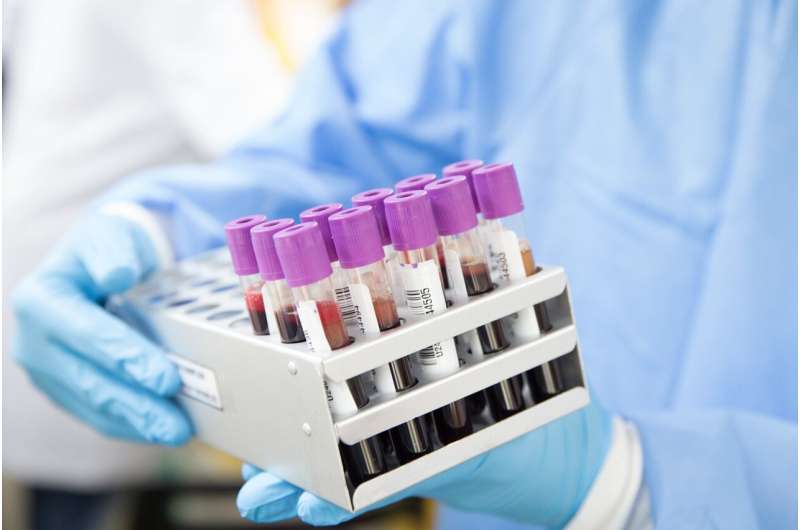Clinical trial leads to a decrease in early deaths from rare and aggressive acute promyelocytic leukemia (APL)

The use of a simplified treatment regimen by oncologists, along with management recommendations and 24/7 support provided by a limited and dedicated group of academic disease experts, resulted in a dramatic decrease in early deaths from acute promyelocytic leukemia (APL).
The finding is from a multi-center prospective trial by the ECOG-ACRIN Cancer Research Group (study EA9131). The primary aim was to decrease induction (days 2–35) mortality from an estimated 30% to 15% or less. Study EA9131 met its primary objective, with a mortality rate of only 3.5%.
Lead researcher Anand P. Jillella, MD, presented the unique collaborative care model December 11 at the 64th American Society of Hematology (ASH) Annual Meeting and Exposition in New Orleans.
"A standardized algorithm with expert support decreases early deaths from APL and increases overall survival," said Dr. Jillella, a medical oncologist and APL expert at the Georgia Cancer Center and Medical College of Georgia at Augusta University. "Most oncologists currently lack access to simplified care instructions and institutional pathways for management recommendations to improve patient outcomes."
APL, a subtype of acute myeloid leukemia (AML), is extremely rare, with only about 3,000 new cases annually in the U.S. In addition, the treatment differs from the treatment of most other types of AML. As a result, many providers lack familiarity with how to treat this disease.
Prompt diagnosis and treatment of APL are critical because patients can quickly develop life-threatening blood clotting or bleeding problems if not treated emergently. With advances over the last decade, arsenic trioxide and non-chemotherapy drugs called differentiating agents, like all-trans-retinoic acid (ATRA), are now the standard APL treatments. These treatments are highly effective; however, the early death rate in APL is high at up to 30%.
"With our current therapies, APL, previously one of our deadliest leukemias, is now curable, and when that happens, people maintain their quality of life and go back to doing what they used to do. But these treatments cause side effects that are not typical of standard chemotherapy and can lead to death. Since most deaths from APL occur in the first 30 days of treatment, if patients survive the first month, it's a home run," said Dr. Jillella.
The three most common causes of early death during the induction period are bleeding, infection, and differentiation syndrome, the latter caused by complications that develop from the treatment. Other risk factors for mortality include older age (over 60 years), comorbid conditions, especially obesity, and the complexity of APL at presentation.
"In my opinion, many early deaths from APL are preventable, and I don't think there is any good reason for most of these patients to die," said Dr. Jillella. "Involvement of clinicians familiar with the potential complications is critical."
The EA9131 collaborative care model provided contact with a disease expert who suggested ways to adjust or personalize standard treatment based on the patient's disease status and risk factors. A total of 202 patients enrolled in the trial; 62 at six lead academic centers and 140 at 37 community hospitals through the National Cancer Institute (NCI) Community Oncology Research Program (NCORP).
There were no exclusions for eligibility based on patient age or general health status.
"Clinical trials for APL tend to enroll younger patients with no comorbid conditions, whereas the general population of APL patients tends to be elderly and with comorbidities," said Dr. Jillella. "However, since many patients present to hospitals where the doctors are not familiar with the intricacies of managing APL, they can benefit from the guidance of someone with more experience."
Seven deaths (3.5%) occurred during the induction period, all due to differentiation syndrome, with four at lead centers and three at community sites. Six of seven deaths were among the elderly (69–91 years).
One-year survival was 94.5%, with no difference between academic and community centers.
"Dr. Jillella has demonstrated that by providing guidance, we can truly optimize the care of and prevent early deaths in APL patients," said ECOG-ACRIN Leukemia Committee Chair Selina M. Luger, MD, the study's APL expert at the University of Pennsylvania's Abramson Cancer Center in Philadelphia.
"This model provides us with a framework to enhance the care of patients with other complex diseases who cannot participate in clinical trials or travel to academic medical centers even if they have limited resources or significant medical comorbidities."
"Based on these results, we are evaluating other ways to provide guided assistance for patients with complicated leukemias and treatment," said Dr. Luger. "Additionally, results of this study have provided insight into treatment modifications for APL patients with significant comorbidities that allow them to achieve remission without additional toxicities."
More information: Abstract 421—A Simplified Patient Care Strategy to Decrease Early Deaths in Acute Promyelocytic Leukemia (APL): Results of the ECOG-ACRIN EA9131 Trial. ash.confex.com/ash/2022/webpro … ram/Paper163436.html
ClinicalTrials.gov Identifier: clinicaltrials.gov/ct2/show/NC … ea9131&draw=2&rank=1

















